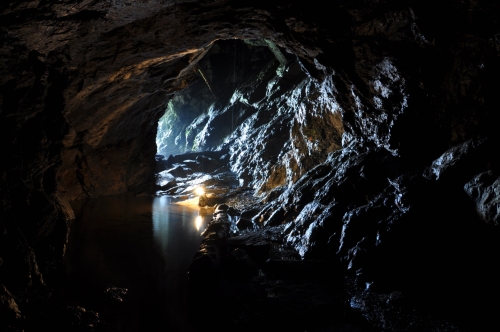
Copper mines.
Copper mines are far less common and less
documented that the talc ones.
In the Germanasca valley there are 2 main groups in the Vallone delle
Miniere and by Grange Pouzét.
They
finished operations at the beginning of the 20th century. Some tunnel
entrances remain open but, as they were fewer, older and smaller as
compared to talc mines, their remains are little visible. More visible
structures can be found in the neighbouring valley Chisone in the area
of mount Beth where bigger mines have been in operation up to 1904 when
a big avalanche destroyed the facilities and killed most of the workers.
Vallone
delle Miniere - 2007
Tunnel entrance.
Old
documents – from 1800 backwards – mention frequently copper in the
Germanasca Valley. As names have changed over time it is not always
easy to make sure they actually are the same sites we know today.
However, as copper have been actually found we can trust these
documents, at least to an extent.
The largest data collection I am
aware of, was made in 1808 Anton Maria Vassalli-Eandi while studying
the reasons for the earthquake that hit the area in that year.
It looks awkward that a search for mines is part of this study!
The
reason behind is that, at that time, the most credited theory about the
origin of the earthquakes was the one about the pyrite fermentation.
Today
it looks silly. But at that time it was the state of the art. We should
remind that the idea that continents move around was understood only in
the 50s of the XX century.
Basically, the pyrite fermentation theory
stated that underground there are large masses of pyrites and large
caverns. When water gets in contact with pyrites the mineral melts
generating inflammable chemicals that fill the caverns. Then, from
times to times, the natural electric phenomena that happen in the
ground, generate explosions which set on fire the caverns and extend to
coal if any.
This was supposed to be the ultimate cause for the ground movements.
Because
of that, Mr. Anton Maria Vassalli-Eandi have been looking for
all
the mines in the area including any kind of mineral.
The research is not fully reliable as it is based on interviews and
older documents; apparently no field research was done.
Nevertheless,
when he deals specifically with copper, he mentions sites that should
be the same still known today. In some cases he quotes people that did
filed research, they collected calchopyrite and roasted it in order to
separate the actual copper form the useless mineral and chemicals
reaching measurements of the available quantity of minerals.
From 1800 onwards the situation is more clear.
In
that period of time metals were very important and governments started
to make laws about mines exploitation much earlier than they did for
non metallic minerals.
There was an institution called Royal Mines Body which took care of
allowing permissions, controlling activities etc.
Over
the time other institutions took over this responsibility and the
archive was given to the National Archives and are today available in
the Turin facility.
Going trough those I found the main steps of the Vallone delle Miniere.
Vallone
delle Miniere - 2007
Landscape.
1847:
the presence of copper mines is listed in the book “Dizionario storico
geografico degli stati sardi” written by Goffredo Casalis.
1956: The
company “L'Esploratrice” is granted the permission to search for
mineral. This company was founded by Camillo Cavour with the target of
improving the use of the mineral resources of the state.
1871:
Giovanni Regis is claims the permission for itself on the ground that
the preceding company did not work in the area too long (the permission
contract stated that if works stop more than 2 years the permission is
automatically cancelled).
1902: Cirillo Tron has the search permission and does major works as
described by many documents.
Sometimes later activities stop and never started again.

Inside one mine.
Picture: 2009.
Basically,
the quantity of available mineral was very little. 7 to 15% on the
total mass of the stone and the thickness of the useful layer was from
few millimetres to some centimetres.
The world was changing.
Importing for the Americas where large quantities of native ore were
available was becoming cheaper and this kind of mining was to disappear
forever.
As far as I understood, no copper was ever commercially
extracted from the mines. Only search works were made. I am not sure
about old times. But even if somebody actually collected copper, by
sure it was an occasional activity which did not leave major visible
traces.
One document linked to the grange Pouzét mines is very interesting from
this standpoint.
At
the end of his report about his visit to the works, the inspector of
the authority declares “I really have no means to suggest any further
search activities".
Vallone
delle Miniere - 2007
Entrance of a tunnel.

